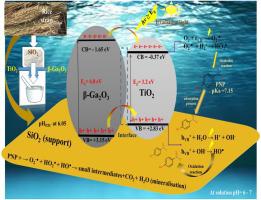Journal of Environmental Chemical Engineering ( IF 7.7 ) Pub Date : 2020-10-18 , DOI: 10.1016/j.jece.2020.104619 Sherif A. Younis , Enas Amdeha , Radwa A. El-Salamony

|
This work was undertaken to provide a new potent route for wastewater treatment by developing a hybrid photocatalyst from waste rice straw. On this basis, rice straw-based SiO2 was utilized as a platform to synthesize a ternary β-Ga2O3-TiO2-SiO2 nanocomposite with type-I heterojunction band alignment using the mechanochemical method. The categorical factorial design was employed to optimize the synergistic effect between adsorption and photocatalytic performance of the nanocomposite towards removing p-nitrophenol (PNP) from wastewater under various experimental conditions. The optimization results indicated the negligible impact of catalyst dose () and total dissolved solids () on the photocatalysis with the increase of pre-adsorption time (Xads) from 60 to 180 min. In contrast, the adsorption/photocatalytic performance of ꞵ-Ga2O3-TiO2-SiO2 was found to be dependent on the solution pH (, with a percentage contribution (PC) of 26.1 %) due to its effect on the photocatalyst surface charge and the dissociation process of PNP molecules. At optimum conditions ( = 4.0 g/L, = 6.0, = 1000 mg/L, and Xads = 180 min), the β-Ga2O3-TiO2-SiO2 exhibited high efficiency to degrade 92.4 ± 3.8 % and 68.65 ± 4.3 % of PNP (25 mg/L) after 120 min UV and visible irradiation, with kinetic rates (k) of 0.62 and 0.53 mg/(g.min), respectively. This improved performance was due to the synergism between (i) the high adsorption of PNP (k = 0.017 mg/(g.min)) on SiO2 and (ii) the effective separation of photogenerated charges between ꞵ-Ga2O3 and TiO2. The high-performance stability (up to 3 cycles) of β-Ga2O3-TiO2-SiO2 was also demonstrated towards UV/visible-induced photodegradation of organic contaminants in real petrochemical wastewater.
中文翻译:

通过ꞵ嘎增强除去对硝基苯酚的2 ö 3 -TiO 2的光催化剂固定在稻草基的SiO 2通过吸附和光催化之间的协同作用的阶乘优化
通过从废稻草中开发混合光催化剂,开展了这项工作,为废水处理提供了一条新的有效途径。在此基础上,稻草基的SiO 2被用作平台以合成三元的β-Ga 2 ö 3 -TiO 2 -SiO 2使用机械化学法的纳米复合材料与I型异质结带对准。在不同的实验条件下,采用分类因子设计来优化纳米复合材料的吸附与光催化性能之间的协同效应,以去除废水中的对硝基苯酚(PNP)。优化结果表明催化剂剂量的影响可忽略不计()和总溶解固体()的光催化作用,预吸附时间(X ads)从60分钟增加到180分钟。与此相反,在吸附/光催化性能ꞵ嘎2 ö 3 -TiO 2 -SiO 2被认为是依赖于溶液的pH值(,由于其对光催化剂表面电荷和PNP分子解离过程的影响,其贡献率(PC)为26.1%)。在最佳条件下( = 4.0克/升, = 6.0, = 1000毫克/升,并且X广告= 180分钟),所述的β-Ga 2 ö 3 -TiO 2 -SiO 2显示出高效率降解92.4±3.8%和PNP(25毫克/升的68.65±4.3%)后120分钟的紫外线和可见光照射,动力学速率(k)分别为0.62和0.53 mg /(g.min)。这种改进的性能是由于(ⅰ)在SiO高吸附PNP(K = 0.017毫克/(g.min))之间的协同作用2和(ii)之间的光生电荷的有效分离ꞵ嘎2 ö 3和TiO 2。的高性能的稳定性(高达3个循环)的β-Ga 2 ö 3 -TiO 2 -SiO还证明了图2可以实现UV /可见光诱导的实际石化废水中有机污染物的光降解。


























 京公网安备 11010802027423号
京公网安备 11010802027423号